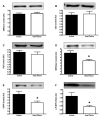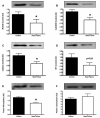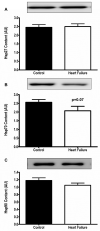Abnormalities of calcium handling proteins in skeletal muscle mirror those of the heart in humans with heart failure: a shared mechanism?
- PMID: 22939042
- PMCID: PMC3437990
- DOI: 10.1016/j.cardfail.2012.07.005
Abnormalities of calcium handling proteins in skeletal muscle mirror those of the heart in humans with heart failure: a shared mechanism?
Abstract
Background: In the failing human heart, abnormalities of Ca(2+) cycling have been described, but there is scant knowledge about Ca(2+) handling in the skeletal muscle of humans with heart failure (HF). We tested the hypothesis that in humans with HF, Ca(2+) cycling proteins in skeletal muscle are abnormal.
Methods and results: Ten advanced HF patients (50.4 ± 3.7 years), and 9 age-matched controls underwent vastus lateralis biopsy. Western blot analysis showed that sarco(endo)plasmic reticulum Ca(2+)-ATPase (SERCA)2a, which is responsible for Ca(2+) sequestration into the sarcoplasmic reticulum(SR), was lower in HF versus controls (4.8 ± 0.5 vs 7.5 ± 0.8 AU, P = .01). Although phospholamban (PLN), which inhibits SERCA2a, was not different in HF versus controls, phosphorylation (SER16 site) of PLN, which relieves this inhibition, was reduced (0.8 ± 0.1 vs 3.9 ± 0.9 AU, P = .004). Dihydropyridine receptors were reduced in HF, (2.1 ± 0.4 vs 3.6 ± 0.5 AU, P = .04). We tested the hypothesis that these abnormalities of Ca(2+) handling protein content and regulation were due to increased oxidative stress, but oxygen radical scavenger proteins were not elevated in the skeletal muscle of HF patients.
Conclusion: In chronic HF, marked abnormalities of Ca(2+) handling proteins are present in skeletal muscle, which mirror those in failing heart tissue. This suggests a common mechanism, such as chronic augmentation of sympathetic activity and autophosphorylation of Ca(2+)-calmodulin-dependent-protein kinase II.
Copyright © 2012 Elsevier Inc. All rights reserved.
Figures






Similar articles
-
The regulation of sarco(endo)plasmic reticulum calcium-ATPases (SERCA).Can J Physiol Pharmacol. 2015 Oct;93(10):843-54. doi: 10.1139/cjpp-2014-0463. Epub 2015 Jan 19. Can J Physiol Pharmacol. 2015. PMID: 25730320 Review.
-
Abnormal sarcoplasmic reticulum Ca2+-sequestering properties in skeletal muscle in chronic obstructive pulmonary disease.Am J Physiol Cell Physiol. 2008 Aug;295(2):C350-7. doi: 10.1152/ajpcell.00224.2008. Epub 2008 May 28. Am J Physiol Cell Physiol. 2008. PMID: 18508908
-
Exercise training delays cardiac dysfunction and prevents calcium handling abnormalities in sympathetic hyperactivity-induced heart failure mice.J Appl Physiol (1985). 2008 Jan;104(1):103-9. doi: 10.1152/japplphysiol.00493.2007. Epub 2007 Nov 1. J Appl Physiol (1985). 2008. PMID: 17975126
-
Co-expression of SERCA isoforms, phospholamban and sarcolipin in human skeletal muscle fibers.PLoS One. 2013 Dec 16;8(12):e84304. doi: 10.1371/journal.pone.0084304. eCollection 2013. PLoS One. 2013. PMID: 24358354 Free PMC article.
-
Sarcoplasmic reticulum Ca2+-ATPase modulates cardiac contraction and relaxation.Cardiovasc Res. 2003 Jan;57(1):20-7. doi: 10.1016/s0008-6363(02)00694-6. Cardiovasc Res. 2003. PMID: 12504810 Review.
Cited by
-
Intact skeletal muscle mitochondrial enzyme activity but diminished exercise capacity in advanced heart failure patients on optimal medical and device therapy.Clin Res Cardiol. 2013 Aug;102(8):547-54. doi: 10.1007/s00392-013-0564-3. Epub 2013 Apr 11. Clin Res Cardiol. 2013. PMID: 23575739 Free PMC article. Clinical Trial.
-
Action potential-evoked calcium release is impaired in single skeletal muscle fibers from heart failure patients.PLoS One. 2014 Oct 13;9(10):e109309. doi: 10.1371/journal.pone.0109309. eCollection 2014. PLoS One. 2014. PMID: 25310188 Free PMC article.
-
Skeletal Muscle Contractile Function in Heart Failure With Reduced Ejection Fraction-A Focus on Nitric Oxide.Front Physiol. 2022 Jun 1;13:872719. doi: 10.3389/fphys.2022.872719. eCollection 2022. Front Physiol. 2022. PMID: 35721565 Free PMC article. Review.
-
Could SGLT2 Inhibitors Improve Exercise Intolerance in Chronic Heart Failure?Int J Mol Sci. 2022 Aug 3;23(15):8631. doi: 10.3390/ijms23158631. Int J Mol Sci. 2022. PMID: 35955784 Free PMC article. Review.
-
Molecular basis for the improvement in muscle metaboreflex and mechanoreflex control in exercise-trained humans with chronic heart failure.Am J Physiol Heart Circ Physiol. 2014 Dec 1;307(11):H1655-66. doi: 10.1152/ajpheart.00136.2014. Epub 2014 Oct 10. Am J Physiol Heart Circ Physiol. 2014. PMID: 25305179 Free PMC article. Clinical Trial.
References
-
- Franciosa JA, Park M, Levine TB. Lack of correlation between exercise capacity and indices of resting left ventricular performance in heart failure. Am J Cardiol. 1991;47:33–9. - PubMed
-
- Higginbotham M, Morris KG, Conn EH, Coleman RE, Cobb FR. Determinants of variable exercise performance among patients with severe left ventricular dysfunction. Am J Cardiol. 1983;51:51–2. - PubMed
-
- Maskin CS, Forman R, Sonnenblick EH, Frishman WH, LeJemtel TH. Failure of dobutamine to increase exercise capacity despite hemodynamic improvement in severe chronic heart failure. Am J Cardiol. 1983;51:177–82. - PubMed
-
- Harrington D, Anker SD, Chua TP, Webb-Peploe KM, Ponikowski PP, Poole-Wilson PA, et al. Skeletal muscle function and its relation to exercise tolerance in chronic HF. J Am Coll Cardiol. 1997;30:1758–64. - PubMed
MeSH terms
Substances
Grants and funding
LinkOut - more resources
Full Text Sources
Medical
Research Materials
Miscellaneous

